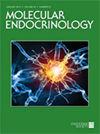研究资源:钙/钙调素依赖性蛋白激酶激酶2 (CaMKK2)在系统代谢中的作用。
Q Biochemistry, Genetics and Molecular Biology
引用次数: 29
摘要
许多流行病学研究表明,钙(Ca(2+))信号是肥胖的一个主要因素,导致系统代谢异常。有些矛盾的是,肥胖与循环Ca(2+)水平降低相关,导致细胞内Ca(2+)储存从内质网释放增加。这些发现表明,与肥胖状态相关的胰岛素抵抗与典型Ca(2+)信号通路的激活有关。从机制上讲,细胞内增加的Ca(2+)与钙调蛋白(CaM)结合,激活一组Ca(2+)/CaM依赖性蛋白激酶。在本研究资源中,我们探讨了Ca(2+)/CaM依赖性蛋白激酶激酶2 (CaMKK2)作为Ca(2+)/CaM作用的代谢效应物的代谢功能和意义。我们揭示了CaMKK2对控制胰岛素从胰腺β细胞释放的重要性,同时影响胰岛素反应组织的敏感性。为了更好地了解CaMKK2缺失对代谢的影响,我们在CaMKK2缺失的小鼠中对葡萄糖、脂肪酸和氨基酸代谢的关键代谢副产物进行了有针对性的代谢组学分析。我们对CaMKK2(-/-)小鼠及其野生型幼崽在饮食应激(低脂饮食、正常饮食、高脂饮食和禁食)条件下分离的3种胰岛素敏感组织(肝脏、骨骼肌、血浆)中的氨基酸和酰基肉碱进行了定量分析,从而揭示了CaMKK2独特的代谢功能。我们的研究结果强调了CaMKK2作为胰岛素作用的分子变阻器,并强调了Ca(2+)/CaM/CaMKK2在调节全身代谢中的重要性。这些发现表明,CaMKK2可能是对抗胰岛素信号紊乱相关合并症的一个有吸引力的治疗靶点。本文章由计算机程序翻译,如有差异,请以英文原文为准。
Research Resource: Roles for Calcium/Calmodulin-Dependent Protein Kinase Kinase 2 (CaMKK2) in Systems Metabolism.
A number of epidemiological studies have implicated calcium (Ca(2+)) signaling as a major factor in obesity that contributes to aberrant systems metabolism. Somewhat paradoxically, obesity correlates with decreased circulating Ca(2+) levels, leading to increased release of intracellular Ca(2+) stores from the endoplasmic reticulum. These findings suggest that insulin resistance associated with the obese state is linked to activation of canonical Ca(2+) signaling pathways. Mechanistically, increased intracellular Ca(2+) binds calmodulin (CaM) to activate a set of Ca(2+)/CaM-dependent protein kinases. In this research resource, we explore the metabolic functions and implications of Ca(2+)/CaM-dependent protein kinase kinase 2 (CaMKK2) as a metabolic effector of Ca(2+)/CaM action. We reveal the importance of CaMKK2 for gating insulin release from pancreatic β-cells while concomitantly influencing the sensitivity of insulin-responsive tissues. To provide a better understanding of the metabolic impact of CaMKK2 loss, we performed targeted metabolomic analyses of key metabolic byproducts of glucose, fatty acid, and amino acid metabolism in mice null for CaMKK2. We quantified amino acids and acyl carnitines in 3 insulin-sensitive tissues (liver, skeletal muscle, plasma) isolated from CaMKK2(-/-) mice and their wild-type littermates under conditions of dietary stress (low-fat diet, normal chow, high-fat diet, and fasting), thereby unveiling unique metabolic functions of CaMKK2. Our findings highlight CaMKK2 as a molecular rheostat for insulin action and emphasize the importance of Ca(2+)/CaM/CaMKK2 in regulation of whole-body metabolism. These findings reveal that CaMKK2 may be an attractive therapeutic target for combatting comorbidities associated with perturbed insulin signaling.
求助全文
通过发布文献求助,成功后即可免费获取论文全文。
去求助
来源期刊

Molecular endocrinology
医学-内分泌学与代谢
CiteScore
3.49
自引率
0.00%
发文量
0
审稿时长
12 months
期刊介绍:
Molecular Endocrinology provides a forum for papers devoted to describing molecular mechanisms by which hormones and related compounds regulate function. It has quickly achieved a reputation as a high visibility journal with very rapid communication of cutting edge science: the average turnaround time is 28 days from manuscript receipt to first decision, and accepted manuscripts are published online within a week through Rapid Electronic Publication. In the 2008 Journal Citation Report, Molecular Endocrinology is ranked 16th out of 93 journals in the Endocrinology and Metabolism category, with an Impact Factor of 5.389.
 求助内容:
求助内容: 应助结果提醒方式:
应助结果提醒方式:


